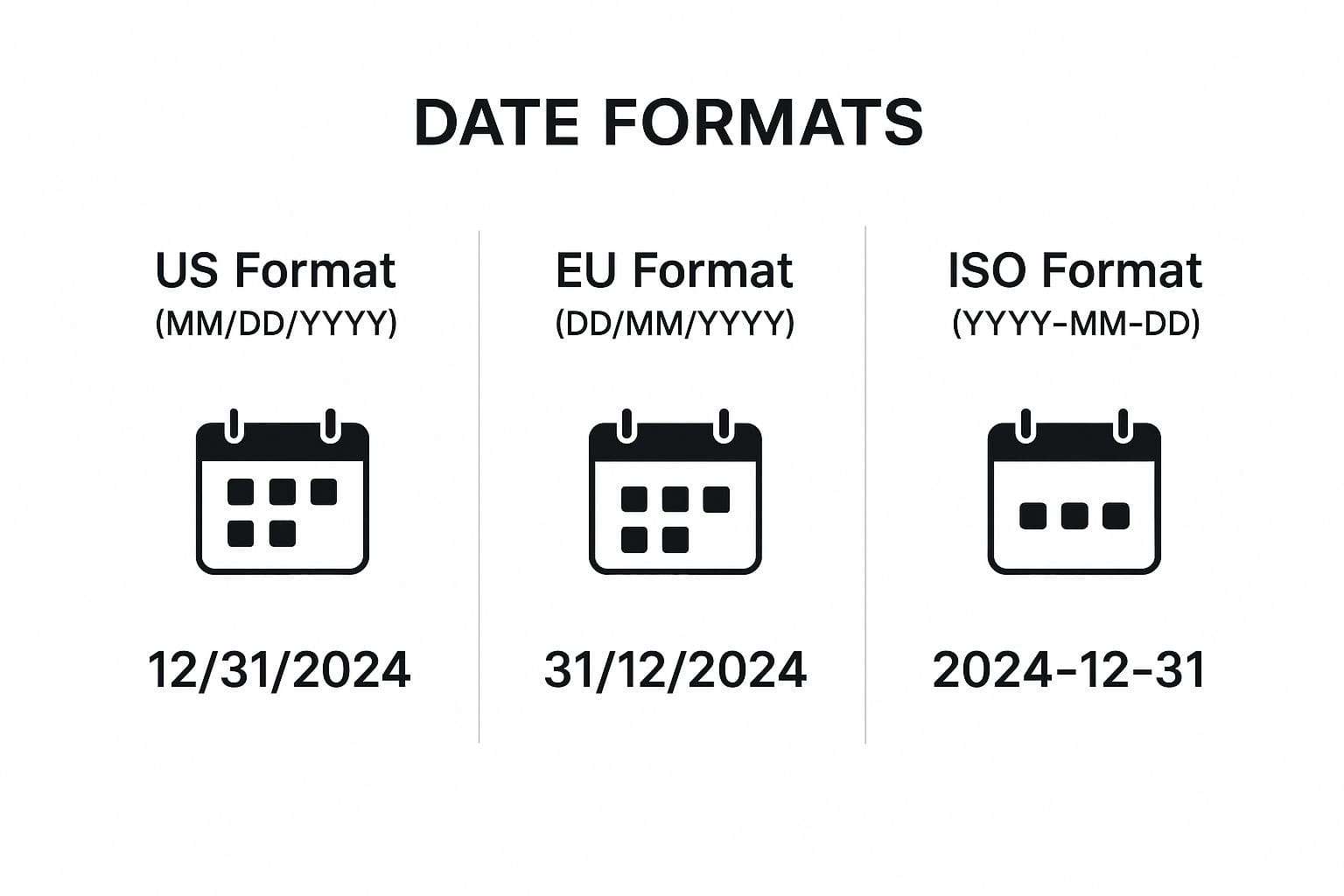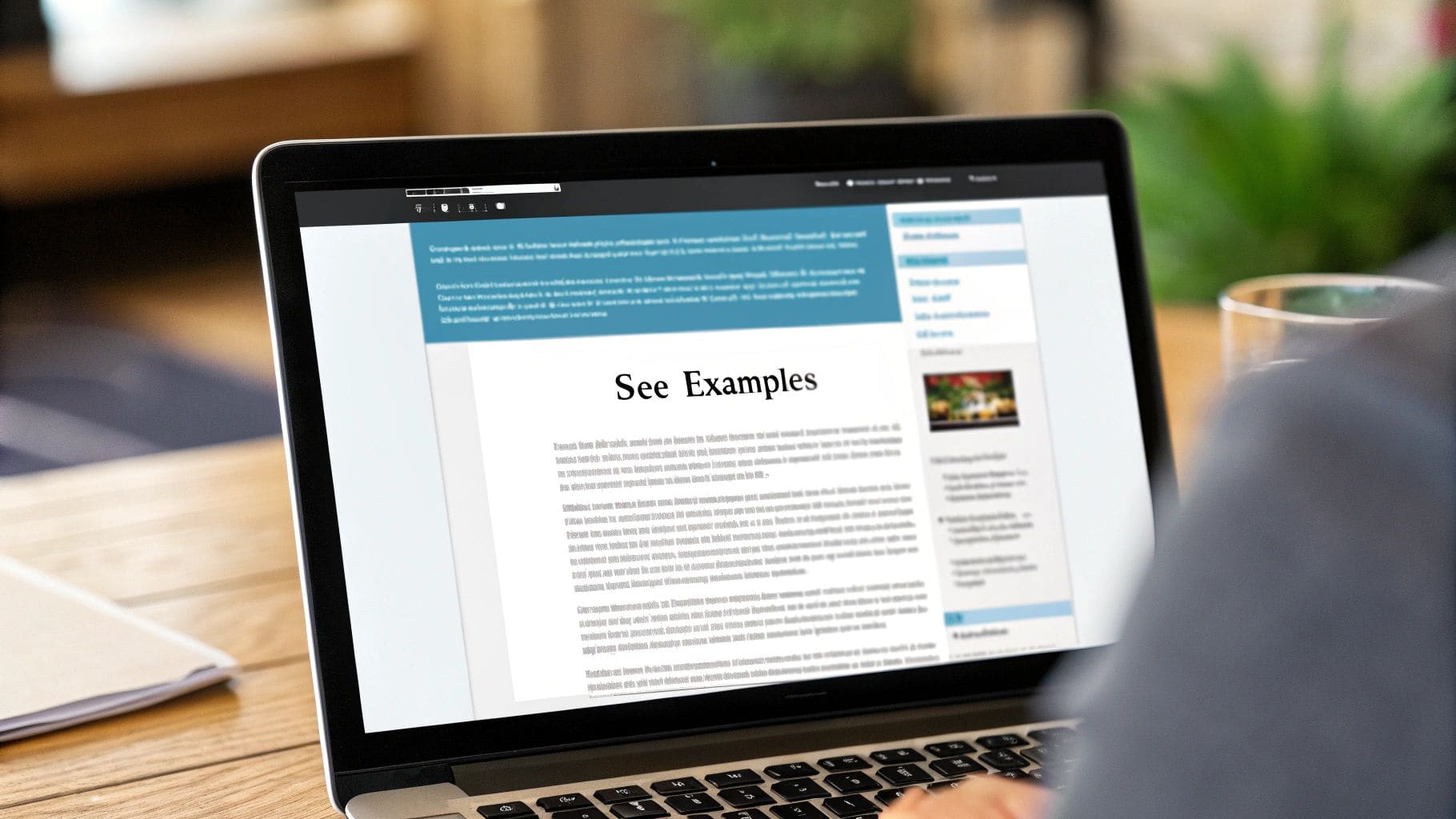A Guide to the Best Resume Date Format
Learn the industry-standard resume date format that works for both ATS systems and human recruiters. Discover how to handle employment gaps, short-term roles, and maintain consistency across your entire resume.

A Guide to the Best Resume Date Format
The best way to write dates on your resume is simple: Month Year. For example, use May 2023 or August 2021. This format is the industry standard because it's instantly understood by everyone—from human hiring managers to the automated systems that scan your resume first. It's clean, professional, and avoids any confusing regional mix-ups.
Why Your Resume Date Format Is So Important

It's easy to treat the dates on your resume as an afterthought. But how you format them sends a powerful signal about your professionalism and attention to detail. Your resume is the timeline of your career. Inconsistent or confusing dates break that timeline, creating friction for the reader and planting a seed of doubt. A clean, consistent date format makes your career progression easy to follow.
This small choice has a huge impact, especially since your resume needs to satisfy two very different audiences.
The Two Audiences You Must Satisfy
Every detail on your resume has to work for two distinct readers:
- Applicant Tracking Systems (ATS): This software is your first hurdle. It scans your resume for keywords and data, including your employment dates, to see if you're a match. An unusual date format can confuse the ATS, causing it to misread your experience or discard your application before a person ever sees it.
- Human Recruiters: Once past the ATS, a person will likely spend only seconds glancing at your resume. A clear, standard date format helps them quickly understand your work history. If they have to struggle to interpret your timeline, it suggests you might be careless with details.
A strong resume speaks to both audiences. It's just as deliberate as crafting a compelling resume objective or summary to hook the reader.
To help you nail this, let's look at the most common formats and their practical outcomes.
Quick Comparison of Resume Date Formats
This table breaks down the good, the bad, and the ugly of resume date formats, so you can see why one clearly comes out on top.
| Format Example | Best For | ATS Friendliness |
|---|---|---|
| May 2023 | Virtually all situations. This is the universal standard—clear, professional, and easy for both humans and software to read. | Excellent |
| 05/2023 | Casual or internal roles. However, it can still cause confusion. | Good |
| May 2021 – Present | Current roles. It clearly signals that you are still employed in that position. | Excellent |
| 2021 – 2023 | High-level summaries or masking short employment gaps. Use it to show tenure over several years without monthly specifics. | Good |
| 05/15/2023 | Avoid this. It's too specific and can inadvertently lead to age discrimination. ATS may also misinterpret it. | Poor |
| Q2 2023 | Niche project-based roles where work is tracked by quarter, but it's not standard and can be confusing. | Poor |
As you can see, spelling out the month and year is your safest and most professional bet. It leaves no room for error and ensures your career timeline is crystal clear.
Get your free CV review
Upload your CV and get instant AI suggestions to improve your chances
Choosing the Right Format for ATS and Recruiters
When you format dates on your resume, your goal is to pick a format that satisfies both the hiring manager and the Applicant Tracking System (ATS) that scans it first. Luckily, the best formats are also the simplest ones. They're clean, professional, and built to avoid any confusion.
The Top 3 ATS-Friendly Date Formats
To make sure your work history is crystal clear, you can't go wrong with one of these three powerhouse formats. Pick one and use it consistently.
- Month Year (May 2023): This is the undisputed champion. Writing out the full month name followed by the four-digit year is completely unambiguous. Action: Use this format for maximum clarity and professionalism.
- Abbreviated Month Year (May 2023): Using a standard three-letter abbreviation (like Jan, Feb, or Mar) is just as effective. Action: Use this to save a small amount of space while maintaining perfect clarity.
- Month, Year (May, 2023): Adding a comma is a style preference. It's acceptable and readable, but functionally unnecessary. Action: If you like the look, use it, but be sure to apply it consistently everywhere.
The most important takeaway is consistency. Once you pick a format, stick with it for every single date on your resume—work experience, education, certifications, everything.
Actionable Tip: A consistent resume date format signals to a hiring manager that you are detail-oriented and professional. In a stack of resumes, this small detail helps you stand out for the right reasons.
One of the biggest traps is using numeric-only dates, which can easily trip up an ATS due to regional differences. This visual shows exactly why spelling out the month is always the smarter move.

A date like 05/10/2023 is a recipe for confusion—is it May 10th or October 5th? By simply writing May 2023, you eliminate all doubt.
Handling Gaps and Short-Term Roles Strategically

Employment gaps, freelance projects, and short-term contracts don't have to be red flags. With a smart approach to date formatting, you can control the narrative and present a story of consistent growth and valuable experience.
How to Format Employment Gaps
When you have a gap of several months or more, the last thing you want is to highlight it. A standard month-and-year format can make a six-month break feel like a massive hole. The solution is to use years only for the jobs surrounding the gap.
Practical Example:
- Instead of this: Senior Analyst (May 2019 – October 2021) and Project Manager (July 2022 – Present)
- Do this: Senior Analyst (2019 – 2021) and Project Manager (2022 – Present)
This simple switch minimizes the visual gap. It keeps the focus on your job titles and tenure, not the time you took off. It's an honest, effective, and perfectly acceptable way to manage your timeline.
Grouping Short-Term and Freelance Roles
If your work history is full of short-term gigs, a resume packed with contract roles can look choppy. To fix this, group related freelance or contract jobs under a single, strong heading. This transforms varied experience into a cohesive and impressive portfolio.
Actionable Tip: Grouping contract work under a title like "Freelance Consultant" or "Independent Contractor" reframes scattered gigs into a deliberate, powerful career choice. It shows you're versatile and can manage multiple projects.
For instance, create one entry for "Freelance Graphic Designer" and then use bullet points to showcase your most impactful projects for different clients. This shifts the focus from a fragmented timeline to your concrete achievements—which is exactly what recruiters want to see. This method instantly makes your resume cleaner and tells a much more compelling story. For more on this, see these examples of how to frame your resume accomplishments.
Applying Consistent Formatting Across Your Resume
Think of your resume as a single story. The date format is its rhythm. When it's steady and predictable, your timeline flows smoothly. When it's inconsistent, it creates a confusing experience for the reader. If you write May 2023 in your Work Experience section, use that exact same style for your Education and Certifications. Mixing formats like "May 2023," "05/2021," and "2019" on the same document looks sloppy.
Standardizing Dates in Every Section
Here is a practical example of how to create a polished, predictable layout.
Before (Inconsistent and Confusing):
- Work Experience: Senior Analyst, 05/2020 – 11/2023
- Education: B.S. in Finance, Graduated 2020
- Certification: PMP Certification, Issued: March 15th, 2022
After (Consistent and Professional):
- Work Experience: Senior Analyst, May 2020 – November 2023
- Education: Bachelor of Science in Finance, May 2020
- Certification: Project Management Professional (PMP), March 2022
The "after" version is instantly easier to follow. The consistent Month Year format removes any mental gymnastics for recruiters and the software they use.
For a degree still in progress, a simple tweak keeps everything clear. Add "Expected" before the date:
Example: Bachelor of Arts in Communication, Expected May 2025
This provides a clear end date without breaking your formatting rules. For certifications, listing the issue date is usually enough, unless the expiration date is critical for the role.
Getting these details right is a powerful signal of your professionalism. To ensure your formatting is flawless every time, you can streamline the process with an online CV builder that helps you maintain perfect consistency automatically.
Using Only Numbers
This is the most frequent and damaging mistake. Writing a date like "05/21" or "05/10/2021" might feel quick, but it's a huge gamble.
- The Mistake: Writing dates using only numbers (e.g., 03/2022).
- Why It's a Problem: This format is ambiguous. In the US, "03/10/2022" is March 10th. In Europe, it's October 3rd. An ATS) can easily scramble your work history.
- The Fix: Spell out the month to remove all doubt.
- Instead of:
03/2022 - Use:
March 2022
- Instead of:
Inconsistent Abbreviations and Styles
Imagine a report where the author swaps fonts and heading styles on every page. That's what happens when you mix date formats on your resume. Using "Jan." in one section and "February" in another looks sloppy and signals a lack of attention to detail.
Actionable Tip: Think of your resume as a professional document where every detail reflects on you. Inconsistency suggests carelessness, a major red flag for any recruiter.
- The Mistake: Using different abbreviations or formats (e.g., Jan. 2021 in one entry and Feb 2022 in another).
- The Fix: Pick one style and stick to it. If you abbreviate, decide on a format (
Jan.orJan) and apply it everywhere. The best practice is to spell out the full month name to avoid this issue entirely.
Including Specific Days
Unless daily precision is critical in your field (which is rare), adding the day of the month is unnecessary clutter.
- The Mistake: Writing the full date (e.g., May 15, 2023).
- The Fix: Keep it clean with just the month and year. This focuses the reader on what matters: the duration of your roles and the scope of your experience.
Frequently Asked Questions About Resume Dates

Even after you've nailed down the basics, a few specific questions about resume dates can pop up. Getting these details right is the final polish that turns a good resume into a great one. Let's tackle the most common questions with actionable answers.
How Should I List My Current Job?
This is a common point of confusion, but the fix is simple. Use the word "Present" to show that a position is ongoing. For your current job, the format should be 'Month Year – Present'.
Practical Example: If you started in May 2021, you would write:
May 2021 – Present
This format is instantly understood by recruiters and easily parsed by ATS software. It is far clearer than alternatives like "Current" or leaving the end date blank.
Is It Okay to Use Seasons for Internships?
It's tempting to write 'Summer 2023' for an internship, but this is where precision matters. Using seasons can seem vague to a recruiter scanning hundreds of resumes. Always stick to specific months to provide the exact timeline hiring managers are looking for.
- Instead of: Summer Internship, Summer 2023
- Do this: Marketing Intern, June 2023 – August 2023
Using months makes your experience crystal clear and your timeline easy to follow.
Should I Include Dates for My Education?
The right answer depends on where you are in your career.
- For recent graduates: Absolutely include your graduation year or expected graduation date (e.g., "Expected May 2025"). This gives recruiters essential context.
- For seasoned professionals: If you are concerned about potential age bias, it is widely acceptable to leave off graduation dates for degrees earned more than 15 years ago. This action keeps the focus on your extensive work experience.
--- Ready to build a resume that stands out for all the right reasons? CV Anywhere transforms your resume into a stunning, interactive web page that gets noticed. Our AI-powered platform ensures perfect formatting and provides built-in analytics so you know who is viewing your profile. Start building your modern resume for free.
Tags
Related Articles
Resume Objective vs Summary: Which to Use for Actionable Results
Resume Objective vs Summary: Which to Use for Actionable Results The real difference between a resume objective vs summary boils down to a single question: are you selling your past or your future? A ...
Read more →How Do I Post My Resume on LinkedIn? Easy Tips to Get Noticed
How Do I Post My Resume on LinkedIn? Easy Tips to Get Noticed Thinking about how to get your resume onto LinkedIn? The best way really comes down to what you're trying to achieve. For maximum visibili...
Read more →7 Resume Accomplishments Examples to Land Interviews in 2025
7 Resume Accomplishments Examples to Land Interviews in 2025 In today's competitive job market, a resume listing only job duties won't get you noticed. Hiring managers and recruiters are looking for c...
Read more →Popular Articles
Finding the right cv template google docs can be a great starting point for your job search, but it's often not the most effective path to getting hired. Whilst templates offer a visual framework, the...
The best way to craft a comprehensive and professional CV of curriculum vitae is with a dedicated tool like CV Anywhere's CV builder. It ensures your document is perfectly formatted and optimised to h...
Stop searching for the perfect template of resume. Trawling through hundreds of options to find one that fits your experience is an outdated, frustrating process. The solution isn't a better template;...
Here is a detailed breakdown of the 12 best options for a resume maker for free available today. We've done the research for you, so you can stop searching and start building a professional, job-winni...
Picking the right resume templates is your first—and most important—move in getting a recruiter's attention. It's not just about looks; a great template is a strategic tool. It organizes your career s...